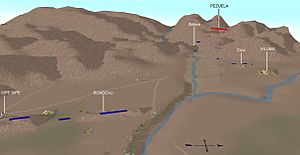Battle of Viluma facts for kids
Quick facts for kids Battle of VilumaBattle of Sipe-Sipe |
|||||||
|---|---|---|---|---|---|---|---|
| Part of Bolivian War of Independence Argentine War of Independence |
|||||||
 Initial situation of both armies before the battle |
|||||||
|
|||||||
| Belligerents | |||||||
| Commanders and leaders | |||||||
| Strength | |||||||
| 3,000 to 3,500 9 field guns |
5,100 23 field guns |
||||||
| Casualties and losses | |||||||
| 2,000 killed, wounded or captured 9 cannons lost |
32 killed 198 wounded |
||||||
The Battle of Viluma, also known as the Battle of Sipe-Sipe, was a very important battle during the South American wars of independence. In this battle, the forces from the United Provinces of the Río de la Plata (which is now Argentina) were badly defeated. They were fighting against the Royal Army from the Viceroyalty of Peru (which was controlled by Spain).
The battle happened on November 29, 1815, on a flat area west of Cochabamba, in what is now Bolivia. This defeat meant that the region of Upper Peru (modern-day Bolivia) was lost to Buenos Aires. Spain took control of the area again.
Contents
What Led to the Battle?
The Army of the North's Journey
The army fighting for independence was called the Army of the North. It was first led by José de San Martín, a famous general. But he had to leave his command because of health issues. So, José Rondeau took over as the new leader.
This was the third time the independence army tried to take control of Upper Peru. The first two attempts had failed. At one point, another general, Carlos María de Alvear, was chosen to replace Rondeau. However, Rondeau's officers refused to obey Alvear. They told Rondeau they would only follow his orders. Rondeau agreed and stayed in charge of the army.
Moving Towards Cochabamba
General Martín Miguel de Güemes and his Gauchos (skilled horsemen) decided to stop supporting Rondeau. They went back to Salta, taking part of the army with them.
Even with this challenge, Rondeau's army kept moving forward. After winning a battle in April at Puesto del Marquéz, they reached Potosí by June. By September, they were in Chayanta. In October, they tried to attack a small Spanish group at Venta y Media but lost. Still, the Army of the North managed to take over Cochabamba.
Setting the Stage for Battle
From Cochabamba, Rondeau's army set up camp on the high plains of Sipe-Sipe. This was near the city of the same name. On November 28, 1815, the Spanish forces arrived. They were led by Brigadier Joaquín de la Pezuela.
Rondeau had about 3,000 to 3,500 soldiers and nine cannons. Pezuela's Spanish army was much larger, with 5,100 soldiers and 23 cannons. The two armies were ready to fight.
The Battle of Viluma
The battle happened the very next day. It was a huge defeat for the independence fighters. In fact, it was one of their worst losses since the Battle of Huaqui in 1811.
The independence army lost about 2,000 men. These were soldiers who were killed, wounded, or captured. They also lost all nine of their cannons. It was a very difficult day for them.
What Happened After the Battle?
Spanish Control Reestablished
Because of this big defeat, the region of Upper Peru was finally lost to the United Provinces. Spain was able to take back full control of the area. This was a major setback for the independence movement.
New Roles for Commanders
For his great success in the battle, Joaquín de la Pezuela was rewarded. In 1816, he was made the temporary viceroy of Peru. A viceroy was like a governor who ruled a large area for the King of Spain. He was also promoted to a higher military rank and given the special title Marquis of Viluma.
On the other hand, José Rondeau was removed from his command in 1816. He then went back to Buenos Aires.
See also
In Spanish: Batalla de Viluma para niños

